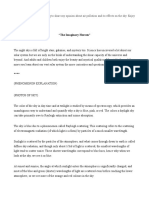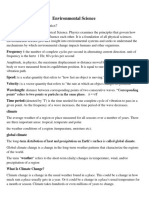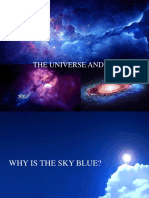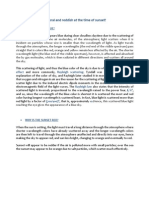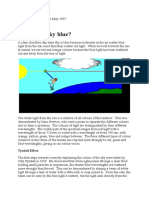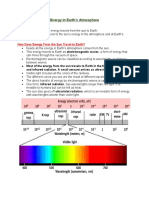Why Is The Sky Blue
Why Is The Sky Blue
Uploaded by
douniaennaciri00Copyright:
Available Formats
Why Is The Sky Blue
Why Is The Sky Blue
Uploaded by
douniaennaciri00Original Title
Copyright
Available Formats
Share this document
Did you find this document useful?
Is this content inappropriate?
Copyright:
Available Formats
Why Is The Sky Blue
Why Is The Sky Blue
Uploaded by
douniaennaciri00Copyright:
Available Formats
Why Is the Sky Blue?
When the sun is high overhead, the bulk of its rays intercept the atmosphere at
nearly vertical angles. Shorter wavelengths of light, such as violet and blue, are
more easily absorbed by air molecules than light from longer wavelengths (that
is, from red, orange, and yellow bands in the spectrum). Air molecules then
radiate violet and blue light in different directions, saturating the sky. However,
the midday sky appears blue, rather than a combination of blue and violet,
because our eyes are more sensitive to blue light than to violet light.
When the sun is near the horizon at dawn , the sun’s rays strike the
atmosphere at more-oblique angles, and thus these rays must travel a greater
distance through the atmosphere than they would at midday. As a result, there
are more nitrogen and oxygen molecules and other particles that can block and
scatter incoming sunlight. During this long passage, incoming radiation in the
shorter blue and violet wavelengths is mostly filtered out, and the influence of
these wavelengths over the color of the sky diminishes. What remains are the
longer wavelengths, and some of these rays strike dust and other particles near
the horizon, as well as the water droplets that make up clouds, to create the
red, orange, and yellow tints we enjoy at sunrise and sunset.
Bulk: the mass or size of something
Wavelengths: the distance between two successive crests or troughs of a wave
Dust: dry powder consisting of tiny particles of earth or waste
Spectrum: a band of colours, as seen in a rainbow, produced by separation of
the components of light by their different degrees of refraction according
to wavelength.
Encyclopedia Britannica: the oldest continuously published encyclopedia in the
world. Its located in the Reid, Murdoch & Co. Building in Chicago
You might also like
- Writing and Speaking: Exercises 4 and 5 P 131: What Is Light ?No ratings yetWriting and Speaking: Exercises 4 and 5 P 131: What Is Light ?1 page
- Environmental Science: What Is Environmental Physics?No ratings yetEnvironmental Science: What Is Environmental Physics?5 pages
- Why Are The Skies Blue and The Sunsets RedNo ratings yetWhy Are The Skies Blue and The Sunsets Red5 pages
- Sharjah Indian School Br. Juwaiza Grade: X Physics-L - 11 The Human Eye and The Colourful WorldNo ratings yetSharjah Indian School Br. Juwaiza Grade: X Physics-L - 11 The Human Eye and The Colourful World4 pages
- Why Sky Is Blue in General and Reddish at The Time of Sunset?No ratings yetWhy Sky Is Blue in General and Reddish at The Time of Sunset?1 page
- Notes For Dispersion and Atmospheric RefractionNo ratings yetNotes For Dispersion and Atmospheric Refraction4 pages
- His Article Is About Earth's Sky. For Other Skies, See - For Other Uses, SeeNo ratings yetHis Article Is About Earth's Sky. For Other Skies, See - For Other Uses, See5 pages
- Energy Interactions in Atmosphere_G2_P1_For_ExaminationNo ratings yetEnergy Interactions in Atmosphere_G2_P1_For_Examination18 pages
- Human Eye and The Colourful World Part 3 UpdatedNo ratings yetHuman Eye and The Colourful World Part 3 Updated4 pages
- 2019-06-27 06 - 33 - 10.082scattering of LightNo ratings yet2019-06-27 06 - 33 - 10.082scattering of Light1 page
- Chapter 7, Factors Affecting Insolation On EarthNo ratings yetChapter 7, Factors Affecting Insolation On Earth19 pages
- Module - 1 Lecture Notes - 3: Remote Sensing: Introduction and Basic Concepts Energy Interactions in The AtmosphereNo ratings yetModule - 1 Lecture Notes - 3: Remote Sensing: Introduction and Basic Concepts Energy Interactions in The Atmosphere10 pages
- Energy in Earth's Atmosphere - G6 Lesson NotesNo ratings yetEnergy in Earth's Atmosphere - G6 Lesson Notes2 pages
- Extraterrestrial Skies Sky (Disambiguation) : Jump To Navigation Jump To SearchNo ratings yetExtraterrestrial Skies Sky (Disambiguation) : Jump To Navigation Jump To Search13 pages
- The Human Eye and the Colourful World L3-4No ratings yetThe Human Eye and the Colourful World L3-427 pages
- The Electromagnetic Spectrum by Cindy GriggNo ratings yetThe Electromagnetic Spectrum by Cindy Grigg2 pages


